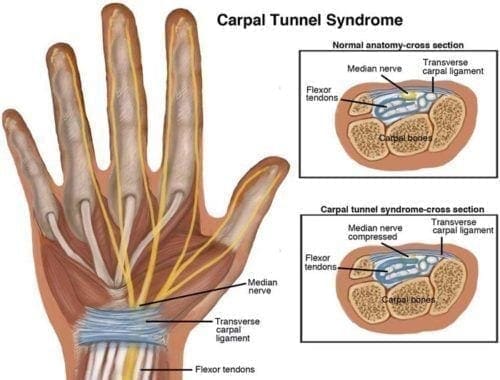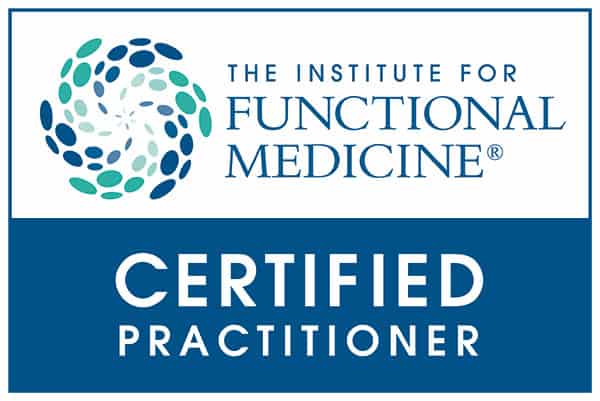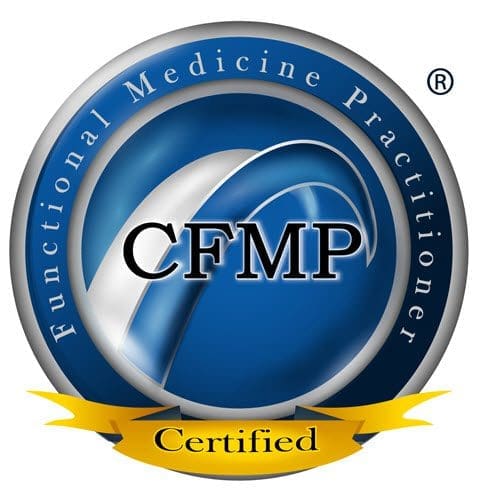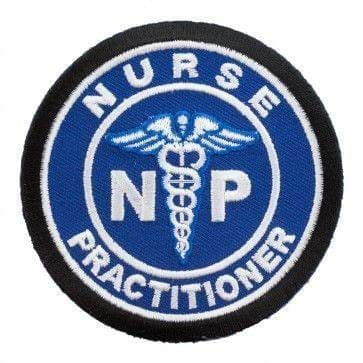Carpal Tunnel Syndrome
Back Clinic Carpal Tunnel Syndrome Team. This is a condition involving numerous symptoms affecting the hands and wrists. This painful condition is caused when the median nerve, found within the wrist’s carpal tunnel and other tendons in hand become compressed. Trauma from an accident to the hand or wrist and/or overuse from repetitive activities, such as constant typing on a keyboard, are common reasons carpal tunnel syndrome develops.
The added pressure begins to irritate and compress the median nerve, leading to impairing pain symptoms, among others. The most common symptoms include pain, numbness, a tingling sensation, and weakness on the hands, wrists, and forearms. Pain and numbness in these areas are usually intense. The discomfort from these symptoms can affect an individual’s everyday lifestyle.
Gripping objects may become difficult as carpal tunnel syndrome progresses over time due to loss of muscle strength. The tingling sensations radiating from the hand are often described as a feeling of pins and needles through the hands, wrists, and forearms.

by Dr Alex Jimenez DC, APRN, FNP-BC, CFMP, IFMCP | Carpal Tunnel Syndrome
Numbness & Tingling
Numbness in any portion of the hand or in specific fingers, followed by a tingling sensation and sharp pain traveling through the hands can occur as a result of various underlying conditions. Many people report symptoms suggesting the development of carpal tunnel syndrome but, although diagnosis might indicate the cause for the condition, sometimes a diagnosis could point to the incorrect root of the problem.
The median nerve and various other tendons travel from the forearm to the hand through a small indentation in the wrist known as the carpal tunnel. The role of the median nerve is to provide movement and feeling in the thumb and first three fingers, excluding the smallest finger in the hand. When an individual begins experiencing the associated symptoms of carpal tunnel syndrome, such as tingling, numbness, weakness, or pain in the fingers or hand, these could be the result to an impingement of the median nerve at the carpal tunnel, generally caused by irritation on the nerves of the wrist.
Thoracic Outlet Syndrome
Although many people could experience numbness in their fingers, the compression could be occurring at another region within the body. Regardless of the cause of your symptoms, if you�re experienced numbness in the hands and fingers, you should consider seeking chiropractic care.
Sourced through Scoop.it from: www.elpasochiropractorblog.com
Carpal tunnel syndrome is a condition caused by an impingement of the median nerve found at the wrist, usually causing symptoms of hand and finger numbness, tingling sensations, weakness, and pain. But, occasionally, the symptoms associated with carpal tunnel syndrome can be caused by complications to the spine, generally the cervical spine. For more information on the subject matter, please feel free to ask Dr. Jimenez or contact us at (915) 850-0900.

by Dr Alex Jimenez DC, APRN, FNP-BC, CFMP, IFMCP | Carpal Tunnel Syndrome
After being diagnosed with carpal tunnel syndrome, it�s associated symptoms are often a cause for anyone to seek immediate medical attention. Carpal tunnel syndrome is a condition caused when the median nerve, found within the carpal tunnel of the wrist, is compressed as a result of irritation, inflammation, or other underlying condition, and is characterized by symptoms of numbness and tingling sensations, weakness, and pain in part of the hand or certain fingers.
Natural Relief for Carpal Tunnel Syndrome
Although carpal tunnel syndrome is well-known as a complication of the wrist, spinal chiropractic adjustments can help with the condition. In fact, many cases of carpal tunnel syndrome can relate to complications on the cervical spine or neck. The median nerve or other nerves that travel through the hands may be impinged at the wrist but those same nerves originate from the neck. Any spinal complication causing a subluxation or misalignment of the spine, restricted mobility in the vertebra, or direct trauma from an injury to the spine, can interfere with the nerve impulse transmissions that trail down the arms and into the hands. A neck issue as the origin of carpal tunnel syndrome can commonly be determined when both hands are affected by the condition and its symptoms.
Preventing Workplace Pain
A chiropractor can help diagnose the source of an individual�s carpal tunnel syndrome. Chiropractic adjustments to the spine will gradually assist to re-align the spine and slowly release compression of the nerves that could be occurring on the spine.
Sourced through Scoop.it from: www.elpasochiropractorblog.com
Carpal tunnel syndrome is most commonly a condition affecting the median nerve at the wrist but most frequently, this condition could be caused by spinal complications. Chiropractic treatment can help alleviate carpal tunnel syndrome and its symptoms by progressively re-aligning the spine through spine adjustments in order to release the compression of the nerves at the level of the spine that could be resulting in numbness, tingling, and pain in the hands and fingers. For more information, please feel free to ask Dr. Jimenez or contact us at (915) 850-0900.

by Dr Alex Jimenez DC, APRN, FNP-BC, CFMP, IFMCP | Carpal Tunnel Syndrome
Carpal tunnel syndrome is a condition involving numerous symptoms affecting the hands and wrists. This painful condition is caused when the median nerve, found within the carpal tunnel of the wrist along with other tendons in the hand, becomes compressed.
The median nerve functions by controlling nerve sensations and impulses from the palm area of the fingers and the thumb as well as to the muscles in the hand, providing feeling and movement. When the tendons become irritated, causing inflammation and swelling, an impingement of the median nerve occurs, resulting in carpal tunnel syndrome. The pinched nerve may then develop a variety of symptoms most commonly associated to the condition.
Symptoms of Carpal Tunnel Syndrome

Trauma from an accident to the hand or wrist and/or overuse from repetitive activities, such as constant typing on a keyboard, are common reasons carpal tunnel syndrome develops. The added pressure begins to irritate and compress the median nerve, leading to the impairing symptoms of pain, among others.
The most common symptoms include pain, numbness, a tingling sensation, and weakness on the hands, wrists, and forearms. Pain and numbness in these areas is usually intense. The discomfort from these symptoms can affect an individual�s everyday lifestyles. Gripping objects may become difficult as carpal tunnel syndrome progresses over time due to loss of muscle strength. The tingling sensations radiating from the hand is often described as a feeling of �pins and needles� through the hands, wrists, and forearms.
By Dr. Alex Jimenez

by Dr Alex Jimenez DC, APRN, FNP-BC, CFMP, IFMCP | Carpal Tunnel Syndrome, Conditions Treated
After a long day of work, it�s not uncommon for people to experience symptoms of pain and discomfort throughout their body. In today�s world, however, everyday activities, such as typing and texting, can often cause more than temporary soreness on the extremities. The repetitive movements of the wrist over time may irritate the surrounding tissues, leading to damage, injury, and even the development of uncomfortable conditions like carpal tunnel syndrome.
What is Carpal Tunnel Syndrome?
Carpal tunnel syndrome is a frequently diagnosed medical condition, characterized by pain, numbness and tingling sensations in the hand and arm. The well-known condition develops when one of the major nerves which runs through the hand, medically referred to as the median nerve, is compressed or impinged as it travels through the carpal tunnel, a narrow passageway within the wrist that is surrounded by rigid tissues, making it minimally capable of stretching or increasing in size.
The median nerve originates from a bundle of nerve roots found in the neck. These roots merge into a single nerve in the arm, where it then travels down the arm and forearm, passing through the carpal tunnel at the wrist and into the hand. This main nerve functions to provide feeling in the thumb and index, middle and ring fingers. The median nerve is also in charge of controlling the muscles around the base of the thumb.
Carpal tunnel syndrome is a common condition which may occur due to a variety of factors. With constant overuse of the hand and wrist, the repeated motions or activities may result to irritation on the tendons in the wrist, causing inflammation and swelling to begin applying pressure against the nerve. Additionally, participating in activities which involve an excessive flexion or extension of the hand and wrist for extended periods of time can also increase pressure on the median nerve. On occasion, hormonal changes brought on by pregnancy can cause swelling. In other cases, the presence of previous conditions like rheumatoid arthritis or diabetes, among other, can also be closely associated with median nerve compression. Furthermore, carpal tunnel syndrome is believed to be caused by hereditary traits. For some people, the carpal tunnel passage may be smaller than average and/or other anatomical differences can in turn change the amount of space between the narrow passageway and the median nerve, leaving people at risk of developing carpal tunnel syndrome. Research shows that women and older individuals have a higher chance of developing this uncomfortable condition.
Fortunately, whether you plan to prevent the development of carpal tunnel syndrome or you�ve been recently diagnosed with the condition, there are several effective treatment options available to relieve the painful symptoms and restore the individuals original hand, wrist and arm function.
Chiropractic and Carpal Tunnel Syndrome
Chiropractic care is one of the most common forms of treatment for carpal tunnel syndrome. Foremost, a doctor of chiropractic, or DC, will evaluate the extent of the condition as well as diagnose the individual to determine any underlying cause behind the condition. After diagnosis, the chiropractor will follow up with an appropriate treatment regimen for the individual, according to their specific needs. Through a series of chiropractic adjustments and manual manipulations, the structures surrounding the hand, wrist and arm can be slowly adjusted to gradually reduce the pressure around the median nerve, ultimately reducing the individual�s symptoms. The chiropractor may also recommend a set of stretches and exercises to carefully restore the individual�s mobility and rehabilitate them back into their original state of well-being.
Sourced through Scoop.it from: www.elpasochiropractorblog.com
The repetitive movements of the wrist over time may irritate the surrounding tissues, leading to damage, injury, and even the development of uncomfortable conditions like carpal tunnel syndrome. For more information, please feel free to contact us at (915) 850-0900.
By Dr. Alex Jimenez
Contact Us
Additional Articles












